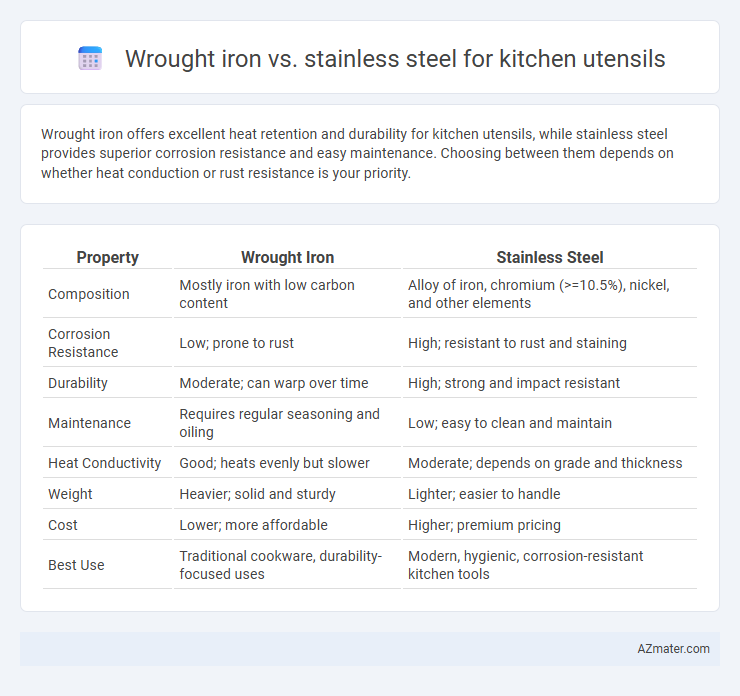Wrought iron offers excellent heat retention and durability for kitchen utensils, while stainless steel provides superior corrosion resistance and easy maintenance. Choosing between them depends on whether heat conduction or rust resistance is your priority.
Table of Comparison
| Property | Wrought Iron | Stainless Steel |
|---|---|---|
| Composition | Mostly iron with low carbon content | Alloy of iron, chromium (>=10.5%), nickel, and other elements |
| Corrosion Resistance | Low; prone to rust | High; resistant to rust and staining |
| Durability | Moderate; can warp over time | High; strong and impact resistant |
| Maintenance | Requires regular seasoning and oiling | Low; easy to clean and maintain |
| Heat Conductivity | Good; heats evenly but slower | Moderate; depends on grade and thickness |
| Weight | Heavier; solid and sturdy | Lighter; easier to handle |
| Cost | Lower; more affordable | Higher; premium pricing |
| Best Use | Traditional cookware, durability-focused uses | Modern, hygienic, corrosion-resistant kitchen tools |
Introduction to Kitchen Utensil Materials
Wrought iron and stainless steel are popular materials for kitchen utensils due to their distinct properties and benefits. Wrought iron is prized for its durability, heat retention, and rustic aesthetics, making it ideal for cookware that requires even heating and long-lasting use. Stainless steel offers corrosion resistance, low maintenance, and a modern appearance, making it suitable for versatile kitchen tools that prioritize hygiene and ease of cleaning.
Overview of Wrought Iron Utensils
Wrought iron kitchen utensils are prized for their exceptional durability, heat retention, and natural non-stick properties when properly seasoned. These utensils develop a protective oxide layer that enhances flavor while preventing rust, making them ideal for high-heat cooking methods such as searing and frying. Their handcrafted construction ensures robust performance, but they require regular maintenance to avoid corrosion and preserve seasoning.
Overview of Stainless Steel Utensils
Stainless steel kitchen utensils are known for their durability, corrosion resistance, and ease of maintenance, making them ideal for daily cooking tasks. Unlike wrought iron, stainless steel does not rust and is non-reactive, ensuring food safety and preserving flavors during food preparation. Their lightweight design combined with heat resistance and a polished finish enhances both functionality and aesthetics in modern kitchens.
Durability Comparison: Wrought Iron vs Stainless Steel
Wrought iron kitchen utensils exhibit exceptional durability due to their high tensile strength and resistance to deformation, making them ideal for heavy-duty cooking tasks. Stainless steel, known for its corrosion resistance and toughness, offers long-lasting performance without warping or rusting under regular kitchen use. While wrought iron requires proper maintenance to prevent rust, stainless steel stands out for its low upkeep and resilience against wear over time.
Heat Conductivity and Retention
Wrought iron exhibits superior heat retention due to its dense structure, allowing kitchen utensils to maintain consistent temperatures during cooking. Stainless steel offers faster heat conductivity, enabling quicker temperature changes but less even heat distribution. Choosing between wrought iron and stainless steel depends on whether sustained heat or responsiveness to temperature adjustments is preferred in kitchen applications.
Maintenance and Cleaning Requirements
Wrought iron kitchen utensils require regular seasoning and oiling to prevent rust and maintain their protective coating, whereas stainless steel utensils are naturally resistant to corrosion and require minimal maintenance. Cleaning wrought iron typically involves hand washing and thorough drying to avoid moisture buildup, while stainless steel can withstand dishwasher use and aggressive cleaning agents without damage. Proper upkeep of wrought iron ensures longevity but demands more consistent care compared to the low-maintenance nature of stainless steel utensils.
Health and Safety Considerations
Wrought iron kitchen utensils offer natural antibacterial properties but require proper seasoning and maintenance to prevent rust and contamination. Stainless steel utensils provide superior corrosion resistance, durability, and do not leach harmful substances, making them safer for prolonged food contact. Choosing stainless steel ensures compliance with food safety standards and reduces risks related to hygiene and chemical exposure in the kitchen.
Aesthetic Appeal and Design Options
Wrought iron kitchen utensils showcase a rustic, traditional aesthetic with intricate hand-forged patterns that add vintage charm to any kitchen decor. Stainless steel offers a sleek, modern appearance with polished or brushed finishes, providing versatility in minimalist or contemporary design schemes. The wide range of stainless steel designs, including ergonomic shapes and multi-functional tools, contrasts with the limited but artisanal craftsmanship found in wrought iron.
Price and Long-Term Value
Wrought iron kitchen utensils typically cost less upfront compared to stainless steel but require regular maintenance to prevent rust and ensure durability. Stainless steel utensils are pricier initially but offer superior long-term value due to their corrosion resistance, low maintenance, and longevity in kitchen use. Investing in stainless steel often reduces replacement frequency, making it a cost-effective choice over time despite the higher initial price.
Which Material is Best for Your Kitchen?
Stainless steel is the best choice for kitchen utensils due to its superior corrosion resistance, durability, and non-reactive properties, making it safe for contact with food and easy to maintain. Wrought iron, while strong and traditional in appearance, requires regular seasoning and can rust if not properly cared for, limiting its practicality in a busy kitchen environment. For long-term hygiene, low maintenance, and versatility, stainless steel ranks as the optimal material for kitchen tools.

Infographic: Wrought iron vs Stainless steel for Kitchen utensil
 azmater.com
azmater.com